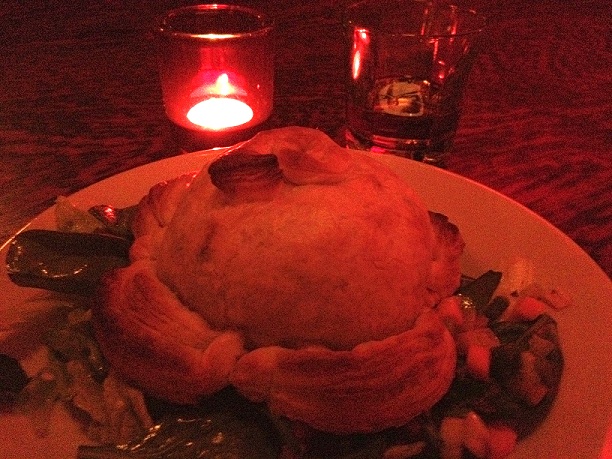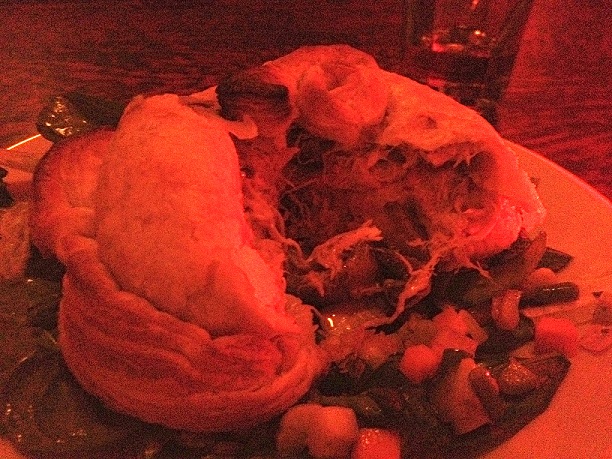Johnny Brenda’s Chef Paul Kimport: My grandmother would make Pennsylvania Dutch Chicken Pot Pie for special company of four or more people, when given at least a day’s notice. The concept of chicken pot pie in Pennsylvania Dutch cooking is more a stew-ish, noodle dish. The “pot” is literally the one regular pot in which the noodles and the stew or broth are cooked together. This dish is served, directly from the large regular pot, by spooning it into individual bowls or large dishes. The distinction between “pot pie” and “noodles” is that “pot pie” is made from flour and water and is cut into large squares, while “noodles” come from an egg noodle recipe and are made thinner and cut long like pappardelle.
We have been serving “chicken pie” — with no “pot” at all — at Standard Tap for about thirteen years now. My idea for this dish was to create something that sounds familiar and yet was also unique to our kitchen at the same time. The chicken pie is puff pastry, filled with basically a beurre manie-enriched, well-bound chicken stew, consisting of chicken, mirepoix and mushrooms.
Part of the philosophy at The Tap has been to work with only the best ingredients available and also to do as much fabrication as we can to utilize the best local resources as fully as possible. Among other dishes, our duck confit and chicken pie were both born from this approach. We will only buy whole chickens at the Tap because it’s the best way to get a chicken. I would hate to cook somewhere where cooks were forced to open cryovac bags of soggy chicken breast. I only want to have a firm wholesome bird under my knife. The chicken pie then efficiently uses all parts of a whole bird and also makes for a homey, warm experience, regardless of being stylized or somewhat unique in nature. My Granny’s cooking certainly inspired the generous utilitarianism in my cooking style. Enjoy my Granny’s Pennsylvania Dutch Chicken Pot Pie!
Johnny Brenda’s Paul Kimport’s Granny’s Pennsylvania Dutch Chicken Pot Pie
Servings: approximately 5 generous servings when using one full chicken
Ingredients:
- One Chicken
- Six cups Flour
- Two and a quarter cups water
- One Head of Celery, diced
- One large Onion, diced
- Salt
- Pepper
Variation for “Noodles” (rather than “Pot Pie”):
- Six cups Flour
- One Dozen Eggs
- Three Tablespoons Lard
Instructions:
To begin making chicken pot pie you should start with a whole bird. Buy the best whole bird possible whenever you cook chicken. All cooks benefit from developing a deeper respect for the animals they cook.
1. Roast the Whole Chicken: I’m proud to recount that my grandmother was more a roaster of birds than a boiler. I believe that roasting can help to develop a great deal of desirable flavor in many things. The browning effect — or its avoidance — is something that should always be considered, in terms of graduated values to be controlled for a desired effect whenever cooking. My Granny would roast the chicken uncovered at a low to moderate heat until done and then set it aside to cool well enough to handle.
2. Make a Flour Roux: From the roasting pan, my Granny would use the schmaltzy liquid to make a flour roux to thicken the broth that cooks the noodles. From the roasting pan, take more than a couple fatty tablespoons and lightly heat it in a saucepan while slowly adding an equal amount of flour and stirring well. Add the rest of the drippings and cook until a nice smooth roux is accomplished. Set aside and reserve for the “pot.”
3. The Pie & Noodles:
- “The Pie:” The pie pieces for Granny’s pot pie is a straightforward water and flour recipe. Three quarter cups water to two cups of flour and a dash of salt. Vary the volume to suit your needs. My grandmother always worked her dough on the kitchen table. For the pot pie, she would make a well with the flour and work the flour in from the side. Work this together quickly until just slightly tacky in the hands, and then rest the dough in a bowl covered with a towel for twenty minutes or more. After it has rested, grab a rolling pin and roll the dough out into small sheets with a little sprinkle of added flour. Rest this dough for a minute or two, and then flour and roll again. Cut equal sized squares from this, and leave them to dry slightly while you wait to add them to the pot.
- Noodles: As an alternative, make a well of flour on the table and then add lightly whisked eggs into it and work until it needs the addition of some of the room temperature lard to finish making it into a tight nearly smooth ball. Rest the dough covered for at least a half hour in a cool place. Portion into smaller balls, and then roll out balls twice or more for a thin noodle and then cut into strips adding additional flour. Allow an hour or two for drying.
4. Finish the stew: Diced onions and celery make a very aromatic cornerstone in the cooking liquid. Heat the onions and celery in the bottom of a pot with a knob of butter until they sing softly for about five minutes and become slightly translucent. Then add the roux and, while stirring quickly, slowly add enough water to cook the noodles. While the pot is getting everything up to a gentle boil whisk and skim your pot. While whisking and skimming, carve and trim the chicken to be used in the pot pie. Ever resourceful, my grandmother would usually reserve some of the bird for later. Cook the dough along with the added chicken and serve when the dough — pie pieces or noodles — has all risen in the pot and has become tender. Salt and pepper to taste. Enjoy!


***
Paul Kimport is the chef and co-owner of Johnny Brenda’s and the co-owner of Standard Tap, recently named one of the Top 50 best restaurants in Philadelphia by Philadelphia Magazine in December of 2012, which is quite impressive for a tavern in a major city.
